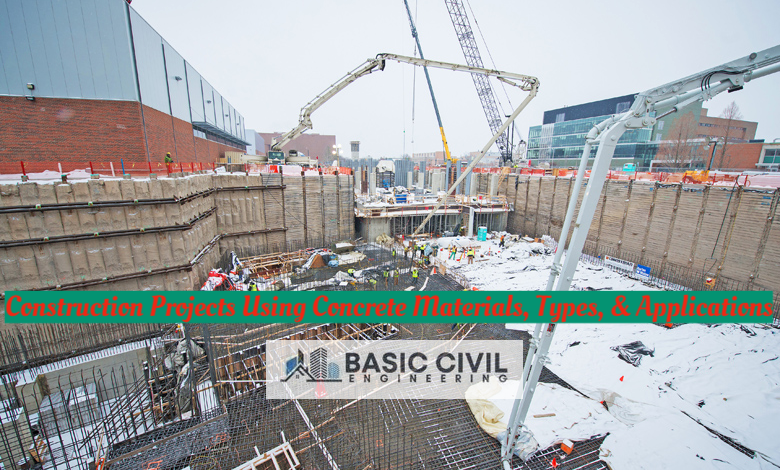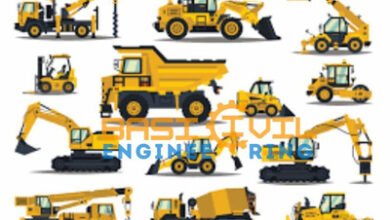Construction projects using concrete: Materials, Types, and Applications

Construction projects using concrete: Materials, Types, and Applications.

WHAT IS THE CONCRETE?
Cement, coarse aggregate, and water are the three main components of concrete, which is a composite material. Concrete can be poured into molds to take on any desired shape by mixing the concrete compounds together to create a fluid mass form of concrete. The consistency of this fluid mass concrete hardens over time. In reality, cement chemically combines with other components to bond them together and create concrete, a hard substance.
MATERIALS OF THE CONCRETE.
Cement
Water
Coarse aggregates / fine aggregates
Admixtures
USES OF THE CONCRETE.
Being able to resist all weather conditions and having increased strength over time make concrete a worthwhile investment for construction. Concrete is a non-combustible building material. Therefore it offers users a sufficient level of safety. Concrete can be shaped in anyway the owner wants before it hardens. Compression is fine for concrete. Concrete is a historically existing building material that is strong and sustainable.
Read More
-
Top 30 Questions and Answers for Interviews About Surveying
-
What’s the Contour Mapping?
-
Responsibilities of a Land Surveyor
-
Five Different Types of The Chains In the Civil Engineering
-
What is Land Surveying and its Types
TYPES OF CONCRETE
i. PLAIN OR ORDINARY CONCRETE
Cement, aggregate, and water comprise most of the components in this form of concrete. This type of concrete is appropriate for projects when great tensile strength is not required because it needs to reinforce.
ii. REINFORCED CONCRETE.
The problem with plain concrete, which is the addition of reinforcement to the bare concrete, is fixed by reinforced concrete. Steel rods, wire mesh, or steel rods can all be used as reinforcement. Rebar and plain concrete work as a single material to endure tensile and compressive forces. Nowadays, this kind of concrete is used in most building structures.
iii. LIGHTWEIGHT CONCRETE
One variety of concrete that includes an expansion ingredient is lightweight concrete. The lightweight aggregate used in lightweight concrete serves as that expansion agent. With the addition of this chemical, the concrete mixture’s volume and dead weight are increased. Lightweight aggregates, including pumice, scoria, shales, and clays, are used to create lightweight concrete. Lightweight concrete is an excellent fire-resistant material, but it is also water-sensitive, labor-intensive to prepare, and potentially breakable like glass (brittleness).
iv. HIGH DENSITY CONCRETE
To create a mixture with a high density and heavy weight, crushed rocks are used. This kind of concrete is frequently used in buildings where it is necessary to regulate radiation.
v. PRECAST CONCRETE
Prestressed concrete makes floor beams, railroad ties, piles, and other structural parts. To make a prestressed concrete element, the stress that will be put on the same element when loaded is placed on the aspect ahead of time. The load doesn’t break the prestressed concrete because of the stress on the whole element.
vi. GLASS REINFORCED CONCRETE
Glass-reinforced concrete is made from a concrete matrix that has strengthened glass fibers that are resistant to alkalis. The composite material does a good job of holding up the load. This type of concrete is used for exterior cladding.
vii. AIR-ENTRAINED CONCRETE
Air-entraining admixtures are added to the concrete mixture when made to make air-entrained concrete. Some tiny air bubbles are put into the plain concrete to create spaces for the water to expand when it freezes. Air-entrained concrete is used to make the hardened concrete last longer in weather conditions like freeze-thaw cycles and to make it easier to work with when the concrete is still soft.
vii. SELF COMPACTING CONCRETE
Since self-compacting concrete doesn’t separate or flow, it must be spread with a machine. This type of concrete is now used to build complex frames.
vii. SMART CONCRETE
Smart concrete is used so that stress or strain can be found before the concrete structure breaks or so that cracks can be fixed before they get too big.




